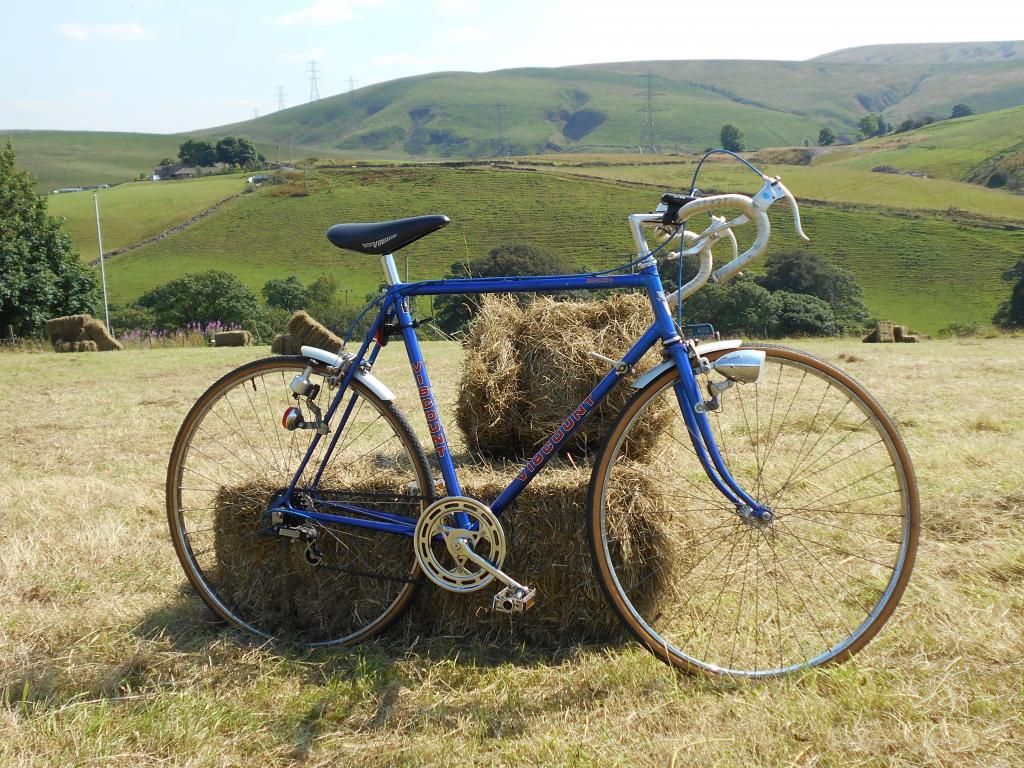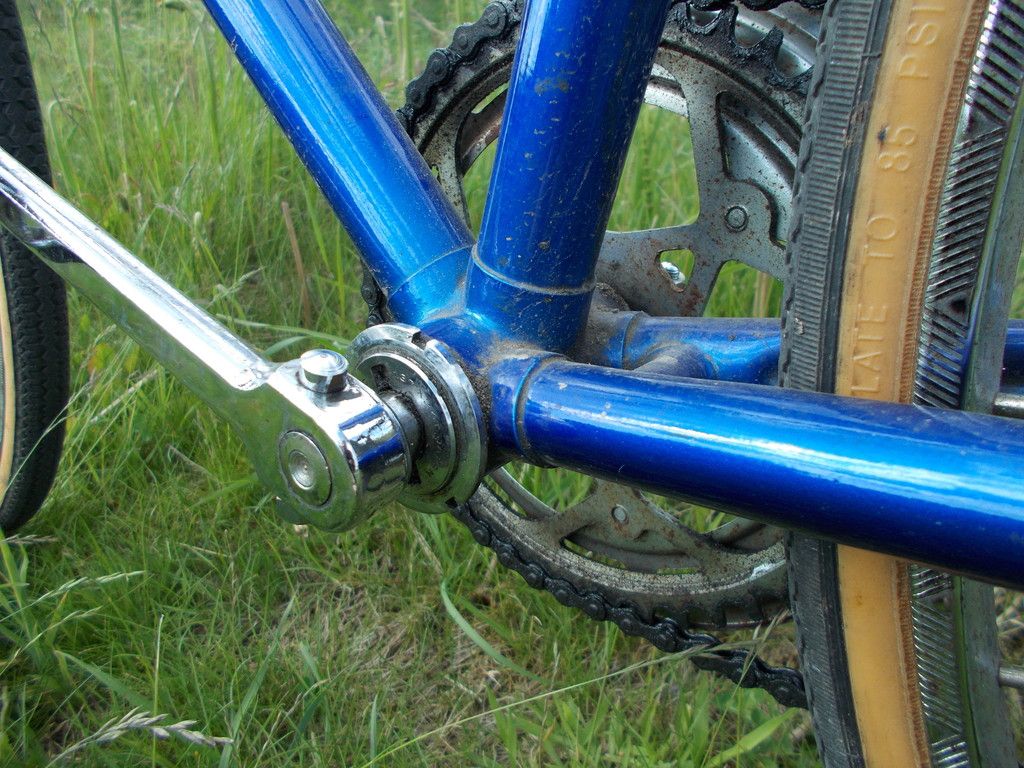|
|
Post by kickstandman on Nov 13, 2015 15:38:21 GMT
www.ebay.co.uk/itm/Vintage-80s-Viscount-Sport-Gents-Road-Racing-Bike-24-5-Steel-Working-Cd-Use-TLC-/111821928931?hash=item1a091b39e3:g:IKMAAOSwAYtWNijW    This set up intrigues me, first,I had a cotter crank that actually seems to thrive in sub zero and wet weather, one can't ask for more at that for durability. It is also interesting that this is a 5 speed, doing away with the front mech/derailleur and being 5 speed, having only one chain ring up front. I wonder if there is much of a weight trade off. The name of the crank is Nervar, there is info on those on the web. It doesn't look too heavy really. Some folks want to run to the hills if they see a cotter crank. I'm not so sure.  Good article on removing cotter cranks: oldbikeblog.blogspot.com/2008/09/how-to-remove-crank-cotters_17.html but as said, if it is not broken. I read one discussion on cotter crank removal where it was said the cyclist loosened up the cotter pins, taking them out and then would ride it and it would come apart eventually. An interesting concept at least. Weight wise, I once bought a generic cotterless crank triple chainring as an experiment to see how the bike would handle it and then, possibly get a good brand in the future, the bike handles it well but that "generic" crank, certainly is heavy, relatively speaking alright.
|
|
|
|
Post by sprockit on Nov 14, 2015 20:17:51 GMT
You don't need to run a mile at the sight/sound/mention of cottered cranks - I've had my 5-speed Sport for about 15 years. It has cottered cranks, and they've been no trouble at all.  Standard English BB thread - 1.37 inches diameter x 24 threads per inch  Mark Stonich at www.bikesmithdesign.com (Minneapolis, USA) makes a cotter press for fitting and removing cotter pins. I have one, but it's very rare that I use it, even though four of our six Viscounts (including Mrs S's La Scala) have cottered cranks, as do all my other bikes. If you want to do hills with a single ring up front, look for the 17t skiptooth freewheel, but you'll need a long cage derailleur to use it, or go for fewer teeth on the chainwheel. I've occasionally seen 10-speed Viscounts with cottered cranks. In my experience they're just as good as cotterless cranks - and there's no JIS, ISO or non-taper to consider. In fact, I think some of the Viscount racing team bikes had cottered cranks, so that's a pretty good endorsement! |
|
robt
Viscount

Posts: 562 
|
Post by robt on Nov 14, 2015 20:52:16 GMT
Don't we get some of our best photos when Sprockit makes a run to the hills?
|
|
|
|
Post by kickstandman on Nov 14, 2015 23:26:03 GMT
I've just been refurbishing the winter steed which has a cottered crank, 2 rings and was thinking of losing the front mech/derailleur and maybe even losing one of the chainrings.
To be brief, CCs have a reputation, deservedly or not of being heavy.
The 5-speed Sport looks excellent in the pictures, thank you for those. An attractive bicycle.
|
|
|
|
Post by sprockit on Dec 10, 2015 23:35:29 GMT
It depends what sort of riding you're going to use the bike for.
The trade-off is strength and durability versus decent stopping in the wet and weight.
The Sport above is used mainly for keeping fit/'training' rides, knocking about on, occasional commuting, and the odd longer excursion if I get carried away. It hardly ever gets used when it's wet or rain is forecast.
It's plus points are that it's components, although hefty, are strong, durable, and all things being equal, mile-for-mile, will outlast the lighter bikes with their 'performance' parts.
The bikes pictured in my 'Pennine Heroes' post in the Photographs section all have cottered cranks, chromed rims and other steel components. The BSA is 50 years old, and splashes daily through muddy puddles on a canal towpath, often travelling 60 miles per week. It's chrome rims don't stop it at all well in the wet, but chrome is a hard metal, and makes the rims resistant to much of the abrasion caused by the grit and mud. If the rims were alloy I'd have to change them every 2 to 3 years. The path is level, and I don't need maximum acceleration, so the weight is of no consequence.
The Sport's minus points are: it's heavy and the 5-speed cluster has an average range - so I don't climb steep or long hills on it; the chrome rims lose a great deal of stopping power in the wet, so I don't do steep descents when it's raining, otherwise I may not be able to stop at the bottom!
To compare three bikes in the Viscount range, mile-for-mile:
Metro 3 - no real performance, but very long lasting;
5-speed Sport - a bit more performance, and still very long lasting;
Aerospace Pro - top performance, but needs parts replacing more often.
Another crank issue that may raise it's head in years to come is that of metal fatigue. A friend and fellow cylist recently told me (rightly or wrongly) that long term stress on aluminium components causes a change in the grain structure which can lead to weakness and ultimate failure/breakage, which is why aeroplanes have a shelf life measured in flying hours.
Whether aluminium alloys are subject to these same changes I don't know, but, in scores of years to come, will we find crank breakages caused by metal fatigue?
Then there's the slow, long term chemical reaction between steel and aluminium when the two metals are used one-against-the-other. I experienced this on my motorcycle where a steel adjuster went through a threaded jaw in an aluminium component. It didn't need adjusting very often, but when it did, the two metals had invariably fused together, leading to breakage of the jaw. I have no experience of this problem on any of my bicycles.
So cottered cranks need not be an issue - it just depends how the bike will be used.
|
|
|
|
Post by kickstandman on Dec 11, 2015 19:06:25 GMT
Thanks for the note, I found a cottered crank to actually be durable in some fairly bad weather. One hears all kinds of stories about cranks, that the bearings can freeze, etc.
|
|